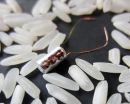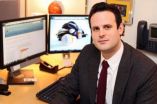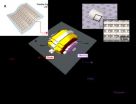(Press-News.org) cientists at The Wistar Institute have developed a mathematical method for classifying forms of glioblastoma, an aggressive and deadly type of brain cancer, through variations in the way these tumor cells "read" genes. Their system was capable of predicting the subclasses of glioblastoma tumors with 92 percent accuracy. With further testing, this system could enable physicians to accurately predict which forms of therapy would benefit their patients the most.
Their research was performed in collaboration with Donald M. O'Rourke, M.D., a neurosurgeon at the University of Pennsylvania Brain Tumor Center, who provided the glioblastoma samples necessary to validate the Wistar computer model. Their findings were published online in the journal Nucleic Acids Research.
"It has become increasingly obvious that understanding the molecular makeup of each patient tumor is the key to personalizing cancer treatments for individual patients," said Ramana Davuluri, Ph.D., Wistar's Tobin Kestenbaum Family Professor and associate director of Wistar's Center for Systems and Computational Biology. "We have developed a computational model that will allow us to predict a patient's exact variety of glioblastoma based on the transcript variants a given tumor produces."
"A gene can produce multiple variants, in the form of transcript variants and protein-isoforms. We found that when you use the gene expression information at variant/isoform-level, the statistical analyses recaptured the four known molecular subgroups but with a significant survival difference among the refined subgroups." said Davuluri. "Using patient data, we found that certain subgroups when combined with patient age, for example, could predict better outcomes using a given course of therapy."
"As more targeted therapies come into use, this is exactly the sort of information clinicians will need to provide the best hope of survival for their patients," Davuluri said. "In time, we think this could form the basis of a clinical test that will help oncologists decide a patient's course of treatment."
Glioblastoma multiforme is the most lethal of the malignant adult brain tumors, and accounts for over 50 percent of all cases of brain cancer. Even with aggressive combination therapies, the prognosis remains bleak, with median patient survival of 15 months after diagnosis. The disease is also molecularly heterogeneous, that is, composed of subtypes that are not genetically alike or produce the same array of proteins. Genetic data from the Cancer Genome Atlas (TCGA) consortium has led to the identification of four subtypes of glioblastoma, but Davuluri and his researchers sought to find a way to quickly identify which patient was which subtype.
In previous studies, Davuluri and his Wistar colleagues have established how changes in the way a cell reads its own DNA can create multiple variations of a single protein. These variant proteins are called isoforms, and they are produced as cells alter how they transcribe a given gene into RNA. Slight changes in how the cellular machine reads a gene can result in protein isoforms with subtle differences in enzymatic activity or longevity.
For example, their earlier research determined how human brains produce different isoforms of specific proteins throughout their lives. Developing fetal brains produce different isoforms of certain genes than adult brains. They also found that changes that trigger the production of the wrong isoform at the wrong time could lead to cancer.
In the Nucleic Acids Research study, the researchers combined assays of these protein isoforms with a computer model they call PIGExClass, or the Platform-independent Isoform-level Gene-EXpression based Classification-system. To categorize glioblastomas with PIGExClass, Davuluri and his colleagues first began with Cancer Genome Atlas data to develop a set of 121 isoform variants whose combination of differences could denote a specific subtype of the brain cancer. PIGExClass is, essentially, a software that ranks gene isoform data into sets based on a set of pre-determined values. The researchers found that, by using this classification system, they could predict the subtype of glioblastoma in the database with 92 percent accuracy.
"When we knew what combination of isoforms could create a specific signature for each type of glioblastoma, we could then create a simple laboratory assay that would look for these differences in patient samples," Davuluri said. "In this case the test would measure variations in the RNA abundance associated with these 121 isoforms that make up the signature."
With this new assay in hand, the researchers validated their research using 206 independent samples from the University of Pennsylvania Brain Tumor Tissue Bank. According to Davuluri, when you accounted for differences in the makeup of the pools of patients between TCGA and Penn, the accuracy of the assay remained the same.
INFORMATION:
Co-authors include Luke Macyszyn, M.D., a neurosurgery resident at the University of Pennsylvania, and Wistar scientists Sharmistha Pal, Ph.D., Yingtao Bi, Ph.D., and Professor Louise C. Showe, Ph.D. This study was partially funded by the National Institutes of Health [award number R01LM011297].
Wistar scientists develop gene test to accurately classify brain tumors
Computer model of gene transcript variants may aid doctors in personalizing therapies
2014-02-18
ELSE PRESS RELEASES FROM THIS DATE:
COXEN model picks the best drug for ovarian cancer
2014-02-18
There are three common drugs for advanced ovarian cancer: paclitaxel, cyclophosphamide, and topotecan. Like a shell game, if you pick the right drug a patient is likely to respond. And, unfortunately, picking the wrong drug can lead to treatment failure. As reported in this month's issue of the journal PLoS ONE, a University of Colorado Cancer Center and University of Virginia study used a sophisticated model of ovarian cancer genetics to match the right tumor with the right drug. Patients who were matched in this way lived an average 21 months longer than patients who ...
A battery small enough to be injected, energetic enough to track salmon
2014-02-18
RICHLAND, Wash. – Scientists have created a microbattery that packs twice the energy compared to current microbatteries used to monitor the movements of salmon through rivers in the Pacific Northwest and around the world.
The battery, a cylinder just slightly larger than a long grain of rice, is certainly not the world's smallest battery, as engineers have created batteries far tinier than the width of a human hair. But those smaller batteries don't hold enough energy to power acoustic fish tags. The new battery is small enough to be injected into an organism and holds ...
Controlling magnetism with an electric field
2014-02-18
Coral Gables, Fla. (Feb. 17, 2014) -- There is a big effort in industry to produce electrical devices with more and faster memory and logic. Magnetic memory elements, such as in a hard drive, and in the future in what is called MRAM (magnetic random access memory), use electrical currents to encode information. However, the heat which is generated is a significant problem, since it limits the density of devices and hence the performance of computer chips.
Scientists are now proposing a novel approach to achieve greater memory density while producing less heat: by using ...
University of Illinois study of 2011 flood will lead to better preparedness
2014-02-18
In May 2011, when the U.S. Army Corps of Engineers used explosives to breach a levee south of Cairo, Ill., diverting the rising waters of the Mississippi and Ohio rivers to prevent flooding in the town, about 130,000 acres of Missouri farmland were inundated. It was the largest flood of the lower Mississippi ever recorded, and researchers from the University of Illinois at Urbana-Champaign took advantage of this "once-in-a-scientific-lifetime" occurrence to study the damage, funded by a National Science Foundation Rapid Response Grant. Their results, published this week ...
Embarking on geoengineering, then stopping, would speed up global warming
2014-02-18
Spraying reflective particles into the atmosphere to reflect sunlight and then stopping it could exacerbate the problem of climate change, according to new research by atmospheric scientists at the University of Washington.
Carrying out geoengineering for several decades and then stopping would cause warming at a rate that will greatly exceed that expected due to global warming, according to a study published Feb. 18 in Environmental Research Letters.
"The absolute temperature ends up being roughly the same as what it would have been, but the rate of change is so drastic, ...
In fight against teen prescription drug abuse, one-two punch wins
2014-02-18
DURHAM, N.C. -- Programs that aim to curb teen prescription drug abuse have vastly differing effectiveness, ranging from big drops in drug abuse to no measurable effect, according to a new study of 11,000 teenagers by researchers at Duke and Pennsylvania State universities.
The best results came from pairing a school-based program with a home-based intervention, resulting in a 10 percent decrease in abuse rates. By contrast, most school-based programs were ineffective when used by themselves, with just one exception.
The six-year study is among the first to measure ...
Research team establishes benchmark set of human genotypes for sequencing
2014-02-18
Led by biomedical engineer Justin Zook of the National Institute of Standards and Technology, a team of scientists from Harvard University and the Virginia Bioinformatics Institute of Virginia Tech has presented new methods to integrate data from different sequencing platforms, thus producing a reliable set of genotypes to benchmark human genome sequencing.
"Understanding the human genome is an immensely complex task and we need great methods to guide this research," Zook says. "By establishing reference materials and gold standard data sets, scientists are one step closer ...
Smartphone app aids college-age women in abusive relationships
2014-02-18
COLUMBIA, Mo. –Women between the ages of 18 and 24 are at the highest risk for dating violence, according to the Centers for Disease Control and Prevention. However, these women are less likely than older adults to seek formal safety resources and instead look to peers or technology for help and advice. In an effort to connect more young women with safety information, University of Missouri researchers collaborated with Johns Hopkins University School of Nursing and the One Love Foundation to develop the "One Love My Plan" smartphone application, an interactive tool that ...
Breakthrough development of flexible 1D-1R memory cell array
2014-02-18
With the introduction of curved smartphones, flexible electronic goods are gradually moving to the center stages of various markets. Flexible display technology is the culmination of the latest, cutting-edge electric cell device technology. Developing such products, however, requires not only a curved display, but also operational precision of other parts, including the memory, in a flexible state.
Dr. Tae-Wook Kim at KIST announced their successful development of a 64-bit memory array using flexible and twistable carbon nano material and organo-polymer compound, which ...
Medicare beneficiaries return to emergency rooms after nursing home discharge
2014-02-18
Nursing homes are widely used by Medicare beneficiaries who require rehabilitation after hospital stays. But according to a recent study led by a researcher at the University of North Carolina at Chapel Hill School of Nursing, a high percentage of Medicare patients who are discharged from nursing homes will return to the hospital or the emergency room within 30 days.
"Nearly two million older adults use this benefit every year," said assistant professor Mark Toles, the first author of the study. "Before this study, we didn't recognize the large number of older adults ...
LAST 30 PRESS RELEASES:
Post-stroke injection protects the brain in preclinical study
Cardiovascular risk score predicts multiple eye diseases
Health: estimated one in ten British adults used or interested in GLP-1 medications for weight loss
Exercise to treat depression yields similar results to therapy
Whooping cough vaccination for pregnant women strengthens babies’ immune system
Dramatic decline in new cases of orphanhood in Uganda driven by HIV treatment and prevention programs
Stopping weight loss drugs linked to weight regain and reversal of heart health markers
Higher intake of food preservatives linked to increased cancer risk
Mass General Brigham–developed cholera vaccine completes phase 1 trial
First experimental validation of a “150-year-old chemical common sense” direct visualization of the molecular structural changes in the ultrafast anthracene [4+4] photocycloaddition reaction
Lack of support for people on weight loss drugs leaves them vulnerable to nutritional deficiencies, say experts
Dogs’ dinners can have greater climate impact than owners’
Are you ready to swap salmon for sprats and sardines?
1.6 million UK adults used weight loss drugs in past year
American College of Cardiology comments on new dietary guidelines for Americans
American Society of Gene & Cell Therapy and Orphan Therapeutics Accelerator partner to advance and commercialize promising rare disease treatments
One in 14 patients having day case surgery have new or worse chronic pain 3 months after their operation
New study highlights link between eviction rates and gun violence
Heatwaves heat up soil but not toxin levels in rice, study finds
Digital modeling reveals where construction carbon emissions really come from
Turning farm waste into water filters
New study shows how the spleen helps the immune system accept a transplant
New Mayo Clinic study advances personalized prostate cancer education with an EHR-integrated AI agent
Researchers identify novel therapeutic target to improve recovery after nerve injury
Microbes in breast milk help populate infant gut microbiomes
Reprogramming immunity to rewrite the story of Type 1 diabetes
New tool narrows the search for ideal material structures
Artificial saliva containing sugarcane protein helps protect the teeth of patients with head and neck cancer
Understanding the role of linear ubiquitination in T-tubule biogenesis
Researchers identify urban atmosphere as primary reservoir of microplastics
[Press-News.org] Wistar scientists develop gene test to accurately classify brain tumorsComputer model of gene transcript variants may aid doctors in personalizing therapies




